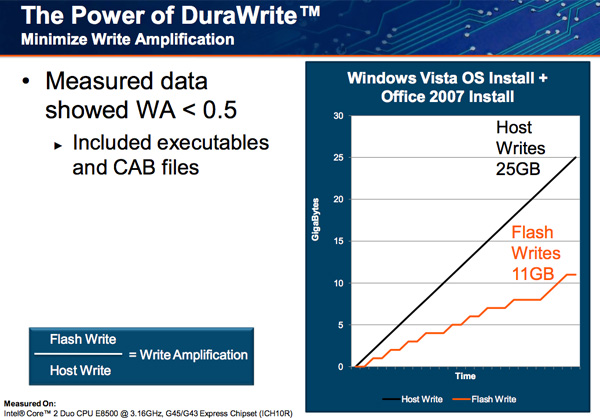SandForce Announces Next-Gen SSDs, SF-2000 Capable of 500MB/s and 60K IOPS
by Anand Lal Shimpi on October 7, 2010 9:30 AM ESTFor months SandForce has been telling me that the market is really going to get exciting once its next-generation controller is ready. I didn’t really believe it, simply because that’s what every company tells me. But in this case, at least based on what SandForce showed me, I probably should have.
What we have today are the official specs of the second-generation SandForce SSDs, the SF-2000 series. Drives will be sampling to enterprise customers in the coming weeks, but we probably won’t see shipping hardware until Q1 2011 if everything goes according to plan. And the specs are astounding:

We'll get to the how in a moment, but let's start at the basics. The overall architecture of the SF-2000 remains unchanged from what we have today with the SF-1200/SF-1500 controllers.
SandForce’s controller gets around the inherent problems with writing to NAND by simply writing less. Using real time compression and data deduplication algorithms, the SF controllers store a representation of your data and not the actual data itself. The reduced data stored on the drive is also encrypted and stored redundantly across the NAND to guarantee against dataloss from page level or block level failures. Both of these features are made possible by the fact that there’s simply less data to manage.

Another side effect of SandForce’s write-less policy is there’s no need for an external DRAM to handle large mapping tables. It reduces the total BOM cost of the SSD and allows SandForce to charge a premium for its controllers.

These are the basics and as I mentioned above, they haven’t changed. The new SF-2000 controller is faster but the fundamental algorithms remain the same. The three areas that have been improved however are the NAND interface, the on-chip memories, and the encryption engine.










84 Comments
View All Comments
tipoo - Thursday, October 7, 2010 - link
...Isn't going to stay relevant long, is it? Already up to 500MB/s SSD's, and SATA 3 isn't even mainstream yet. Its going to become a bottleneck soon, just like SATA II is for current SSD's.rundll - Thursday, October 7, 2010 - link
Well, OCZ introduced few days back a new data link interface HSDL to handle Sata bottlenecks. Let's see what this means in real life.aguilpa1 - Thursday, October 7, 2010 - link
Break out your piggy banks if this is the wavejonup - Thursday, October 7, 2010 - link
They are a private company. As Anand said, a success of the new controller might force them in an IPOiwodo - Thursday, October 7, 2010 - link
Can we plug 2 SATA 6Gbps into a Single 2.5" SSD? We manage to max out SATA 3.0 in one go, and it is SATA 3.0 not even widely available yet.I hope the there would be at least some minor improvement in their DuraWrite and other part of the controller. Otherwise it looks like an overclocked Sandforce with better NAND interface to me.
Firmware should be less of an issues, since it is similar to older chips, the firmware should be stable enough.
Cant wait......
rundll - Thursday, October 7, 2010 - link
"...Otherwise it looks like an overclocked Sandforce with better NAND interface to me"Did we read the same article?
nexox - Thursday, October 7, 2010 - link
Ehh, you know 12Gbit SATA/SAS is due out in 2012, right? That's about in time for Sandforce's 3rd gen controller.And just because they've managed to double their bandwidth with this generation doesn't mean they've still got another trick up their sleeves to double their bandwidth again for the rev after this one.
Iketh - Thursday, October 7, 2010 - link
we're not talking physical limitations of a head moving back and forth on a spinning disk.... doubling performance at the least is much more the norm in the realm of silicon, nothing remotely close to a "trick" about itsoftdrinkviking - Friday, October 8, 2010 - link
I hope we get light peak before that; I just like the idea of my data flashing around through my pc in bursts of light. It's all so very "future is now."iwodo - Saturday, October 9, 2010 - link
No Trick, DDR NAND @ 133Mbps x 8 Channel already gives you just over 1Gbps SSD.And that is with CURRENT tech, the best thing about SSD is that it is easily scalable. You could do 10 Channel like Intel, ( Expensive ), or 16 Channel for total bandwidth since you get 16 Chips on a SSD.
You could also speed up NAND with DDR tech or small node but higher clockspeed.
The only limitation is how fast the controller could work. Which we still have much headroom.